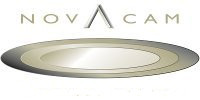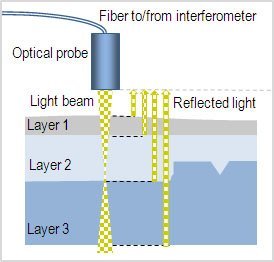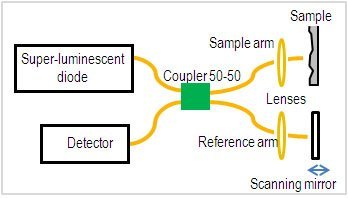How low-coherence interferometry (LCI) works
Principles of low-coherence interferometry
Low-coherence interferometry (LCI) is a non-contact optical sensing technology.
An optical probe directs a beam of low-coherence light at a sample surface and sends reflected light signals to an interferometric detector (interferometer) via an optical fiber for interpretation. When, as in the diagram, the measured sample consists of a stack of semi-transparent material layers, light reflections are simultaneously received back from the top and bottom of each layer.
The interferometer interprets the reflected optical data from each single scan point as an interference pattern and records it as a depth profile (A-Scan). A cross-section (B-scan) is obtained by displacing the probe in a linear fashion across the sample. A 3D volumetric image is generated by combining multiple cross-sections.
Note that scanning is collinear: the emitted and reflected light signals travel along the same axis, enabling the measurement of surfaces with sharp edges, channels, etc.
A low-coherence light beam from an optical probe scans through a multilayer film. Note: the emitted and reflected light actually travels along the same axis (collinear scanning).
How a low-coherence interferometer works
As stated above, the interferometer analyzes the light reflected from the sample to the optical probe.
Two main types of low-coherence interferometers – time-domain (TD) and frequency-domain using swept source – differ by the source of their light and by details of their implementation.
Time-domain (TD) interferometers use low-coherence light from a super-luminescent diode. The light is fed into a fiber-optic coupler that splits the light beam into two arms (paths), one directed at the sample surface, the other at a scanning reference mirror. The detector then captures the interference of light rays reflected back from these two arms. Constructive interference is observed as an intensity maximum when the optical paths of both arms are exactly equal. By scanning the length of the reference arm to bring forth the appearance of the interference signal, the detector determines the precise position of the reflection point in the sample.
Frequency-domain interferometers with swept source (SS) use light from a fast sweeping laser source instead of a super-luminescent diode. The reference mirror is fixed. The detector captures the spectrum of the interference pattern in time and then converts this spectrum to the time domain using Fourier transformation.
Time-domain low-coherence interferometry uses a scanning reference mirror
Comparing time-domain and frequency-domain (with swept source) interferometers
Time-domain LC interferometers
- perform at a scanning speed reaching a few kHz
- are very robust and immune to saturation since the interferometric fringes are encoded in frequency
- maintain sensitivity regardless of scanning depth
Frequency-domain LC interferometers with swept source
- perform at high and very high scanning speeds (20 kHz and higher)
- maintain sensitivity with higher speeds
- lose sensitivity with increased scanning depth
Both types of LC interferometers
- are immune to air perturbation and to cutting the beam
- know the absolute distance of the sample surface when they are turned on, with no need to count fringes (unlike interferometers that use coherent laser-light sources)
Novacam manufactures both time-domain and frequency-domain interferometers under the trademark name MICROCAMTM-3D/4D.
Related links
Learn more about:
- What all we can measure with LCI technology
- Advantages that NOVACAM fiber-based LCI systems offer
Check out NOVACAM 3D metrology systems based on LCI
Contact us or request free sample analysis to see if NOVACAM low-coherence interferometers are suitable for your application


